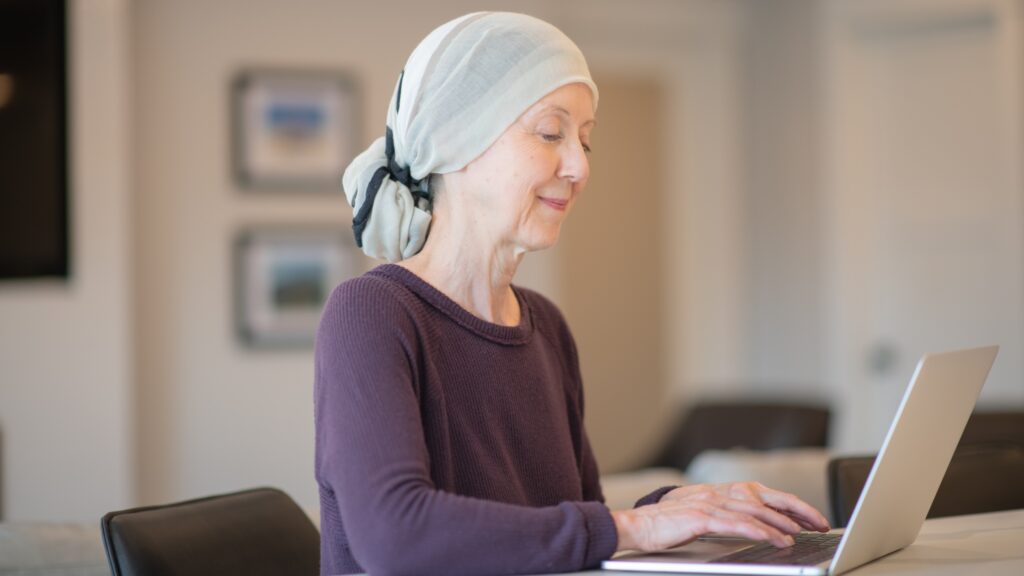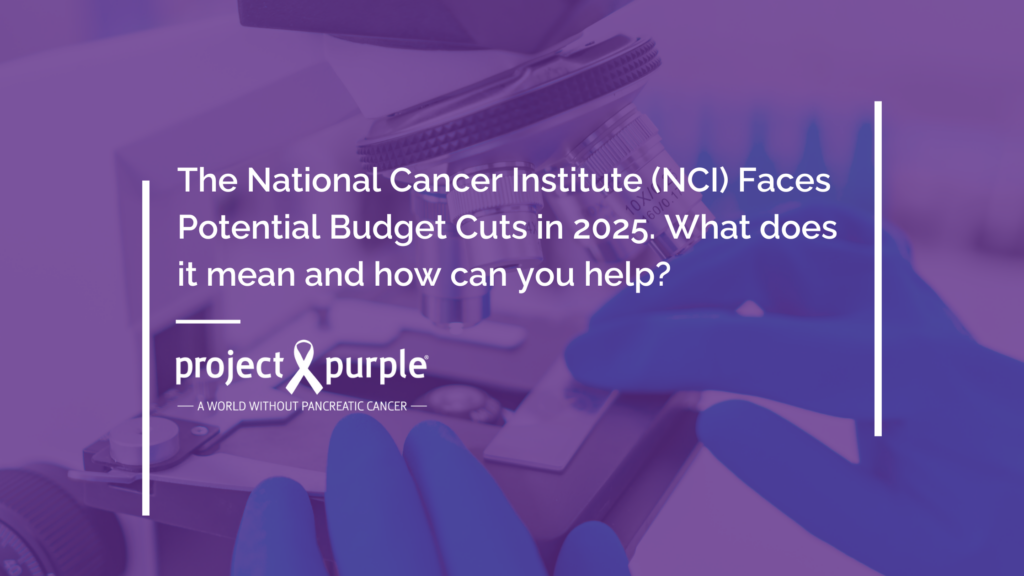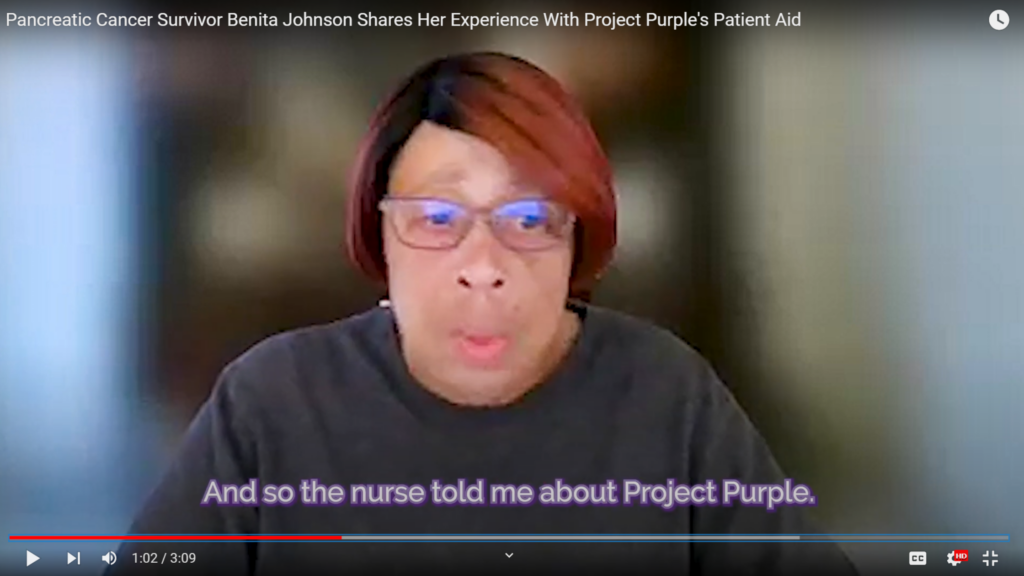
Receiving a pancreatic cancer diagnosis comes with a lot of added stress. Patients often have to juggle making decisions about their health, family life, and work life, all while trying to get better. While at Project Purple, we feel that physical and emotional health come first, and we know that many patients often worry about what to do about their jobs. In this article, we will discuss how to approach taking leave, what accommodations you can have if you decide to work while going through treatment, how to address cancer in the workplace, and what you can do to prepare for going back into the office, should you choose to do so.
We highly recommend taking a leave of absence to focus on your health. However, whether it be for financial reasons or simply preference, some patients decide to work while enduring treatments. The goal of this article is to provide some guidance; both to those who choose to take leave so that they properly utilize their benefits and to those who choose to work in hopes of making it easier to do so.
Getting Medical Leave
How you handle your diagnosis is a highly complicated and personal decision. Know that your health should be your top priority, regardless of your financial situation. If you are concerned about taking time away from work, know that there are resources to help get you through your time off. In this section, we will discuss how you can still feel financially sound, while also taking care of yourself.
If you decide to take a break from your job, consider applying for medical leave. According to the National Foundation For Cancer Research, the Family and Medical Leave Act states that an employer must give a patient 12 weeks of medical leave over the course of a 12-month period. They also state that as long as the patient has been in their position for at least a year in the past seven years and has averaged about 24 hours of work per week, they are likely able to receive aid under the Family and Medical Leave Act.
Know that this time cannot be held against you should you ever seek a promotion or search for any other positions within your workplace. The National Foundation For Cancer Research states that under the Americans with Disabilities Act (ADA), you are protected from such discrimination.
The ADA not only protects patients from discrimination but also allows them to have access to aid. According to the US Equal Employment Opportunity Commission, cancer patients can be considered disabled and therefore receive necessary support through the ADA.
If you do decide to stop working, there are several different ways you can continue to support yourself and/or your family. Below are some financial resources patients may have access to in order to ease the financial burden of pancreatic cancer.
Purchased Disability Insurance
If you do not have disability income insurance that is purchased, please skip ahead to “Applying for SSI”
Some patients, before they are diagnosed, purchase disability income insurance. Programs like these work to ensure you still have an income if you unexpectedly cannot continue working due to an injury, illness, or new disability. Policyholders may have long or short-term disability insurance, and each policy has its own requirements and parameters for how much aid you have access to.
In general, if you have a disability insurance policy, you will likely have to wait a certain amount of time known as an elimination period, STD, or LTD before you can access your insurance benefits, according to Guardian Life. Check with your insurance company to see what your elimination period is on your policy.
Each policy will come with its own definition of what “disability” means. According to Guardian Life, several different definitions can be used. An own-occupation disability definition states that you can access the policy if you cannot work in the chosen occupation you are currently working in. An any-occupation disability states that you can access your policy only if you cannot work in any job you are reasonably suited for, which is determined based on your education, training, and previous work experience. According to Guardian Life, there are also different understandings of the level of disability a person is experiencing, so please check with your insurance company for more details when accessing your policy’s benefits.
Please review the specifics of your policy before requesting benefits from your insurance company to be sure you qualify for access to those benefits.
Applying for SSI
Because pancreatic cancer patients can be considered disabled under the ADA, they can qualify for the Supplemental Security Income (SSI) program and receive benefits based on their needs. According to the American Cancer Society, SSI can provide resources to help meet basic needs such as food, clothing, and shelter.
To apply for SSI, visit the US Social Security Administration’s website. Once you click on the application button, the website will ask you questions about the nature of your application. When asked which program you want to apply for, select Supplemental Security Income for Disability, which is the program designed for individuals with a disability who need financial assistance. There is no age limit on this; a person must be eighteen years or older to qualify. For additional benefits, we recommend clicking on Disability, as pancreatic cancer falls under the umbrella of disabilities.
The website will bring you to a new page that details how to apply and what information you will need. In general, patients will need to submit information about previous appointments and/or treatments along with a list of their medications. The application also requires that you have to submit your Social Security number and banking information so that all benefits you receive go to the right person. You will also need information about your work, and other personal assets such as a car loan agreement or life insurance policy. Lastly, you will be asked to submit information about your current living situation and any corresponding documentation like a rental contract or the name of your landlord.
According to the US Social Security Administration, once your application is submitted, the Social Security Administration will review your application and then forward it to the Disability Determination Services office in your state. From there, your state’s office will decide whether or not you qualify for SSI. This process can take between three to six months. Once the decision has been made, your state’s Disability Determination Services office will send you a letter with their response.
Applying for SSDI
Some patients also may be able to access Social Security Disability Insurance (SSDI). This is a federal benefit for people with disabilities that prevent them from working, according to the American Cancer Society. However, to qualify for SSDI, a patient must have recently worked a job where part of their income went towards Social Security.
To apply for SSDI, the US Social Security Administration recommends reviewing the Adult Disability Checklist to make sure you have all the necessary documentation. In addition to the personal and medical information discussed previously, you will also be asked to submit information about your previous job, including your salary, any previously held positions, and any military service, if applicable. You can apply online or over the phone by calling 1-800-772-1213 between the hours of 8:00 a.m. to 7:00 p.m. Monday through Friday.
According to the US Social Security Administration, the application is reviewed the same way as an SSI application. This process will also take between three and six months, and you will also receive a letter in the mail with the notice of the decision.
There are also more specific resources available for patients based on their specific needs. The American Cancer Society has a great article with resources available for cancer patients. Please make sure to visit their site for further details.
Apply for Patient Aid Through Project Purple
If you find yourself needing more resources or help during your caregiving journey, Project Purple also has several programs you can utilize. Our Patient Financial Aid (PFA) program offers assistance to families in an effort to ease the financial burden of cancer. Project Purple’s Patient Financial Aid program provides grants to qualified patients to help with medical and everyday living expenses. Since its inception in 2012, the program has paid more than $800,000 to help more than 1,200 patients cover medical bills, utilities, and housing expenses.
We also have recently extended our PFA program to provide food assistance to patients and their families. Our partnership with Nutré will provide healthy and convenient meals to our patients and their families so they can further focus on recovering from pancreatic cancer. For more information on our programs, please click here.
Working with Your Diagnosis
If you do decide to continue working while going through treatment, there are ways to make the transition easier on yourself. Remember, your top priority is getting well, so let’s discuss how you can get back to work with your diagnosis in mind.
Chemotherapy affects the body in many ways, and not all patients have the same type of symptoms or experience them the same way. If you plan to keep working while undergoing treatment, you and your healthcare provider should consider how you will manage the side effects of your treatments. The American Society of Clinical Oncology recommends that you speak with your doctor before resuming work, as you may not be ready, or may need to maintain a specific regimen to keep up with your treatments.
Regardless of your treatment plan, federal and state laws may entitle you to certain accommodations during your diagnosis. According to the US Equal Employment Opportunity Commission, under the ADA persons with cancer are entitled to “reasonable accommodations” in their work environment based on their health needs. The American Society of Clinical Oncology gives the example of switching an employee out of a task that has them working with food if they are experiencing nausea during treatment. Some other examples of accommodations, according to The American Cancer Society, include:
- Providing or modifying different equipment or devices used on the job
- Offering a patient a part-time or modified work schedule, which might include working from home or a hybrid work environment.
- Giving employees additional breaks for resting or taking medications.
- Adjusting the temperature in the office
- Shifting a patient into a vacant position or assigning tasks if the patient can no longer do their current job.
- Adjust or modify tests, training, or policies to accommodate the patient’s needs.
As your diagnosis progresses, your plans for going back to work may also change. Know that it is okay to revisit your accommodations, update your boss, or take time off if you need time to rest. Work with your doctor and your employer to decide what work scenario works best for you. Keep in mind that the most important thing is to listen to your body, and your healthcare provider, so that you can take proper care of yourself.
Pancreatic Cancer in the Workplace
As a patient, you need to do what is best for you. Though you are under no obligation to tell anyone about your pancreatic cancer diagnosis, you are required to speak with your employer if you are seeking medical leave or ADA accommodations.
The American Cancer Society suggests that if you continue to work during treatment, you should set up a meeting with your boss to discuss your decision. They recommend being honest about the hours you may need away from work to complete your treatments and explaining that these hours may change as you go through your diagnosis. All conversations you have with your boss about your medical situation must stay confidential; whatever information you share will only be repeated if you give them the okay.
If you do decide to tell your coworkers about your pancreatic cancer diagnosis, keep in mind that you can share as much or as little as possible. The American Cancer Society recommends that you consider how this diagnosis will affect your work, keeping in mind how you plan to manage your health in the workplace. If you are concerned about how to address your diagnosis with your coworkers, please consult Caner.org’s article on talking about your diagnosis.
Though most coworkers will be supportive of you during your diagnosis, you may also experience some prejudice at work. The American Cancer Society suggests that if you believe you will be subject to workplace discrimination because of your diagnosis, you should talk to your Human Resources department.
If you do face issues with discrimination, The American Cancer Society recommends that you look into how your company has dealt with such issues in the past and keep notes on your contacts with other office personnel as well as your past job performance records. All of this information may help you advocate for yourself should you choose to file a discrimination complaint or bring the issue to HR. For more advice on how to handle such a situation, please consult Cancer and Careers’ article on patients’ legal rights in the workplace.
Preparing To Return To Work During Your Diagnosis
If you are returning to work after a pancreatic cancer diagnosis, it is going to become even more important to prepare for the day-to-day. Having a plan in place will help you better adjust and cope with your diagnosis while at work.
The first step is to go in with a good mindset. According to Cancer and Careers, focusing on what you can control, especially on a day-to-day scale is important. Remember that you can always delegate, or ask for help based on your needs throughout the day, both at work and at home.
Before returning to work, remember that one of the best ways to help yourself is to feel prepared. Cancer and Careers has a list of articles detailing how you can help yourself feel ready to return to the workplace. They recommend several different ways to manage your side effects including tips on nutrition and fashion. A few of these suggestions include:
- Get yourself a protective head covering of some sort, especially if you have been experiencing hair loss. Look for hats, turbans, or scarves that completely cover your head to protect against UV rays.
- Dress for comfort as well as fashion. For example, for women, opting for flatter shoes is best for marinating comfort, and protecting against onsets of fatigue. You should also avoid more revealing clothing to protect against UV rays. If you are feeling self-conscious about your appearance, looser, more covering clothing may also help you feel more comfortable. Lastly, avoid irritating fabrics that can harm your skin.
- If you are choosing to wear makeup to work, Cancer and Careers has an article dedicated to how to use makeup products while going through treatment. As always, the biggest thing to remember is to use products that protect your skin. They also have a great section for nail care.
Cancer and Careers also recommends a few strategies for getting back into the swing of things at work. One of their most important suggestions is to slow down your work pace to what feels comfortable. For example, if multitasking is too overwhelming, focus on one task at a time. You can prioritize your most important tasks by making a list and working off of it until you feel comfortable working at a faster pace again. They also recommend taking regular breaks, especially for rest and medication, which are extremely important. The American Society of Clinical Oncology recommends setting alarms to remind yourself to take breaks and medications as needed.
Prepping for getting back to work will not only help you settle back in, but it will also help you maintain a sense of normalcy. Consult with your doctor on additional preparations you can make to help yourself get back into the swing of things.
Bottom line: do what’s best for you.
Whether you choose to continue working or go on medical leave, know that your top priority is taking care of your own needs. We know that there are a lot of stressors that come with a pancreatic cancer diagnosis, but work doesn’t have to be one of them. We highly recommend consulting with your medical team before making any decision like this. And remember, Project Purple is here to help! For more information about our programs, please click here.
If you or a loved one is looking for support, visit our Patients & Families Page to see the programs we provide to directly help patients and apply.
If you’re looking for advice, inspiring stories of survivors, or updates about Project Purple, please visit our News and Stories page.



